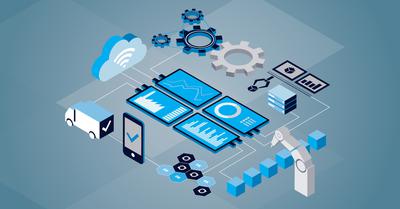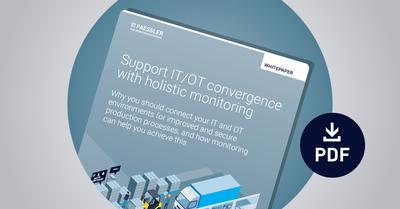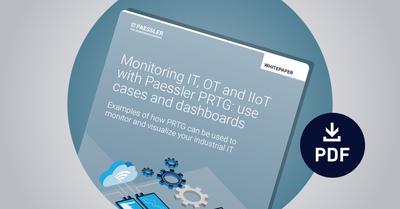PLC stands for programmable logic controller. A PLC is a programmable computing device that is used to manage electromechanical processes, usually in the industrial niche. A PLC is sometimes referred to as an industrial PC, a term that describes a PLC’s main function as a specialized industrial computing machine.
PLCs monitor the state of an input device such as signals from a light switch, and make decisions about the next state of an output device, for example switching a light on or off.
PLCs are also used to transfer information from devices at factories or from offsite locations to centralized applications, often running on PCs. PLCs are commonly used for device monitoring and reporting, to diagnose faults in hardware devices like industrial machines and tools, and to effect device events.
PLCs are the successors of relay logic systems, which are control systems that monitor and control low-level devices like switches, relays, timers, actuators, and motors. In relay logic systems, relays perform logic operations, known as relay logic, by activating and deactivating magnetic coils in electric circuits.
Relays can connect circuits that use different currents and voltages so, historically, they were ideal for controlling and coordinating different industrial automation devices.
The disadvantage of a relay logic system is that, like a switchboard, it is hard-wired and difficult to maintain due to the multiplicity of wires. The development of microcontrollers solved this problem by enabling relay logic processes to be coded programmatically and to be stored on a computer.

PLC components
A typical PLC is connected to a power supply and consists of a central processing unit (CPU), a mounting rack, read-only memory (ROM), random access memory (RAM), input/output (I/O) modules, a power supply, and a programming device.
PLCs have a modular design; I/O and other specialized modules slide into a PLC rack. PLC modules are sometimes called cards.
Rack
A PLC rack can be compared to a car’s chassis with which other components are connected. The connected components in a PLC rack are grouped into three sections: the CPU, multiple I/O modules, and the power source.
Power supply
The power supply converts alternating current (AC) to direct current (DC). DC is used by the CPU and I/O components.
CPU
As with a PC, the CPU is the brain of a PLC. The CPU has two operational modes: programming mode and run mode. In programming mode, the CPU downloads logic in the form of programming instructions created by a user on a PC. In run mode, the CPU executes the logic.
The CPU controls all PLC operations according to the programming instructions stored in memory. A control bus system transfers information to and from the CPU.
I/O modules
A PLC receives or senses data from input devices like proximity and photoelectric sensors, keyboards, level meters, timers, counters, console lights, electric motors, and temperature and pressure switches. The concept of sensing data refers to the nature of PLC input data which comes in the form of electronic signals.
Digital input cards handle discrete signals, for example on/off signals. Analog input cards convert voltage into numbers the CPU can understand.
PLC outputs include valves, starter motors, drives, actuators, solenoids, alarms, control relays, printers, and pumps.
Digital output cards turn devices on and off, for example a light. Analog output cards convert digital numbers to voltage, for example to drive machinery.
PLCs can make logical decisions and perform actions based on the input data they receive, for example processing input data and sending processed data to an output device. The processing of input data is executed by a programming device.
For instance, a temperature switch may monitor the temperature at a cooling plant and intermittently send this information via a PLC to a printer in a factory’s operation center.
Programming device
The programming device is usually a PC, console, or hand-held proprietary device. I/O modules direct input signals into a PLC's CPU where output signals are created. The format of output data is specified by an application program implemented on the programming device.
Memory and storage
ROM stores operating system data and drivers. RAM stores the status of, and details about, input and output data, and application programs.
Communication
I/O modules are responsible for transferring information between the PLC and communication networks.
To communicate with external devices, PLCs use Recommended Standard 232 (RS-232), which is a serial communication standard. RS-232 uses binary code to read and write data in the American Standard Code of Information Interchange (ASCII) format.
At the control level, PLCs communicate with field components at the physical level using a variety of communication protocols depending on the component. PLCs also use different communication protocols to communicate over networks and with wireless devices.
Modbus RTU is a serial communication protocol often used in industrial communication networks to transmit data over long distances. Serial communication protocols, however, lack the performance and speed of Ethernet protocols. Ethernet protocols used by PLCs include Ethernet TCP/IP, Modbus TCP/IP, and Profinet, which are used to connect to plant networks and to the internet. Proprietary protocols may be customized for proprietary devices. Universal Serial Bus (USB) protocols are used to connect to drivers and printers. For wireless devices, the Bluetooth protocol may be used.
PLC life cycle
A PLC performs four basic operational functions. First, it scans any connected input devices for their operational status. Second, it executes a program that determines what should happen with the input data. Third, it generates executed output data. Fourth, it uses an operational housekeeping function to perform internal diagnostics.
Human machine interface (HMI)
PLCs use a range of ports and communication protocols to connect to control applications like supervisory control and data acquisition (SCADA) systems.
Operators at industrial plants and line managers interact with a PLC in real time using an HMI. An HMI is the operator's dashboard, that is, the interface between a person and the PLC. An HMI allows an operator to coordinate, manage, and control industrial processes and devices.
PLCs are used for a wide variety of automated machine processes, for example controlling elevators or turning light switches on and off in smart buildings. PLCs are used to monitor security cameras and automated warning devices, traffic lights, and industrial processes like cutting glass and paper.
A PLC monitors run-time data, for example device uptime, operating temperature, and usage statistics. It also starts and stops processes and generates notifications if a machine malfunctions.
PLCs are used in product assembly, packaging, motion control, batch control, machine diagnostics and testing, and robotics processes.

Ladder logic is commonly used to program PLCs but other languages are also used, for example function block diagram, structured text, sequential function chart, and instruction list.
Ladder logic uses graphical diagrams based on relay circuit hardware to express and specify the logical structure of processes in PLC software applications. Ladder logic code looks like an electrical schematic.
The advantages of PLCs are primarily the benefits attained by doing away with traditional hard-wired logic control systems. Compared to traditional logic control systems, PLCs are easier to build, install, maintain, and modify.
PLC components do not require complex wiring because the control logic is implemented by the software. Modifications and updates can easily be implemented by uploading a new ladder logic program. Modifications can be done remotely instead of manually as is the case with relay logic systems.
Ladder logic coding allows the fast development of complex logical expressions. Programming PLCs are relatively simple and because the design of a PLC system is modular, they can be installed in different physical setups and are easily scalable with multiple different input and output devices.
PLCs are specialized devices built to withstand harsh environmental conditions like cold and extreme heat, and dusty and humid conditions in factories.
A PLC is embedded with a real-time operation system that has certain housekeeping functions but does not require the supplementary utilities PCs use like antivirus software or registry cleaners.
Being microprocessor based, PLC execution times are faster than relay logic control systems, which have multiple mechanical parts.
Complex programming code is often better managed by traditional PCs than PLCs because they are task driven rather than event driven.
Although ruggedly reliable, systems that use PLCs usually need external monitors to display data in a user-friendly way.
When they break down, PLCs may require extensive troubleshooting by PLC specialists.
Get your free white papers
White paper I
In modern industrial IT, the right teams need the right data. Our guide shows how to implement holistic monitoring that brings elements from IT, OT and IIoT into your dashboards.
White paper II
Our second guide gives you inspiration and ideas for dashboards that feature IT, OT and IIoT data – all in one place. We show you what truly convergent industrial dashboards look like!
What is the difference between a PC and a PLC?
A PLC is often described as a “ruggedized digital computer” but there are some key differences.
While a PC is required to run a PLC, a PC does not need a PLC to function. This is because a PLC is run using a microcontroller while a PC runs a microprocessor.
A PLC uses a scan-based method to execute code while PCs use an event-based method to execute code.
PLC inputs are signals rather than the data fed into from PC drives. Often data from a PLC is collected by a PC and used to trigger work orders, reports, and notifications.
A PLC’s operating system is designed to carry out control tasks and so, unlike with PCs, they do not generally use antivirus or registry cleaning utilities.
PLCs are programmed using proprietary vendor languages or ladder logic. PCs are programmed using high-level languages like Java or C++.
PLCs are not immune to cybersecurity attacks and malware but reported instances are fewer than PCs. The reason for this is that PLCs have limited functionality compared to PCs.
Small PLC systems are usually cheaper to implement than a similar use case for a PC but large PLC systems required for complex logic operations can be expensive. Being more suited to harsh environmental conditions, PLCs can be cheaper to physically maintain.
What is the difference between relay logic and ladder logic?
Control circuits in relay logic systems need to be hard-wired for every single control function. Relay logic relies on performing logic and control functions based on diagrams of physical electronic circuits.
Using ladder logic, logic and control functions are performed using a programmable microprocessor-based PLC. The PLC stores the ladder logic program in memory. Unlike hard-wired control systems, PLCs can be reprogrammed, saving time and money as expensive wires and cables do not need to be replaced. Only I/O devices in a PLC require hard wiring.
What is the difference between a microcontroller and a microprocessor?
The terms microcontroller and microprocessor are sometimes used interchangeably but there is a big difference between the two. A microprocessor chip only has a CPU. A microcontroller consists of a CPU, memory, and input/output (I/O) modules all embedded on one chip.
A microprocessor cannot operate independently of other components, like additional circuits and memory, I/O modules, and software.
A microprocessor is used when a lot of complex processing is required, for example for gaming and in laptops, and where a task is undefined. A microcontroller is used for repetitive, predefined tasks, for example in electronic equipment and industrial machines.
Microcontrollers are cheaper, smaller, and use less power than microprocessors.
PLCs allow users to program specific tasks for machines to perform using the ladder logic coding language. PLCs enable the cost-effective automation of repetitive tasks in industrial niches. They are also able to perform smart tasks like automatically issuing work orders and diagnosing malfunctioning equipment.
At the core of industrial systems are complex networks that often communicate over large distances. PRTG is a network monitoring tool that mitigates downtime in industrial systems and that helps to assess the efficiency of resource consumption.
PRTG can be used to monitor smart edge gateways, report on metrics from IoT/IIoT sensors, and use Node-RED to configure data across hardware, online services, and APIs.
- https://www.unitronicsplc.com/what-is-plc-programmable-logic-controller/
- https://www.machinedesign.com/learning-resources/engineering-essentials/article/21834250/engineering-essentials-what-is-a-programmable-logic-controller
- https://ladderlogicworld.com/relay-logic-vs-ladder-logic/
- https://www.techwalla.com/articles/difference-between-plc-microprocessor#:~:text=A%20microprocessor%20is%20only%20one,complete%20computer%20with%20a%20microprocessor.
- https://www.techwalla.com/articles/difference-between-plc-microprocessor#:~:text=A%20microprocessor%20is%20only%20one,complete%20computer%20with%20a%20microprocessor.
- https://www.polytechnichub.com/advantages-disadvantages-programmable-logic-controller-plc/
- https://www.mobileautomation.com.au/plc-industrial-application/#:~:text=Areas%20where%20programmable%20logic%20controllers,technologies%20where%20it%20is%20applied.
- https://www.amci.com/industrial-automation-resources/plc-automation-tutorials/what-plc/
- https://www.whatisdifferencebetween.com/technology/what-is-the-difference-between-plc-fpga-microcontroller-and-microprocessor.html
- https://en.wikipedia.org/wiki/Fieldbus#:~:text=The%20fieldbus%20links%20the%20PLCs,or%20digital%20I%2FO%20signals.
- https://library.automationdirect.com/plc-communications-coming-of-age/
- https://www.electrical4u.com/programmable-logic-controllers/
- https://info.panelshop.com/blog/inside-machines-pc-vs-plc-comparing-control-options#:~:text=One%20of%20the%20major%20difference,translate%20into%20different%20programming%20philosophy.
- https://www.nodered.org/


